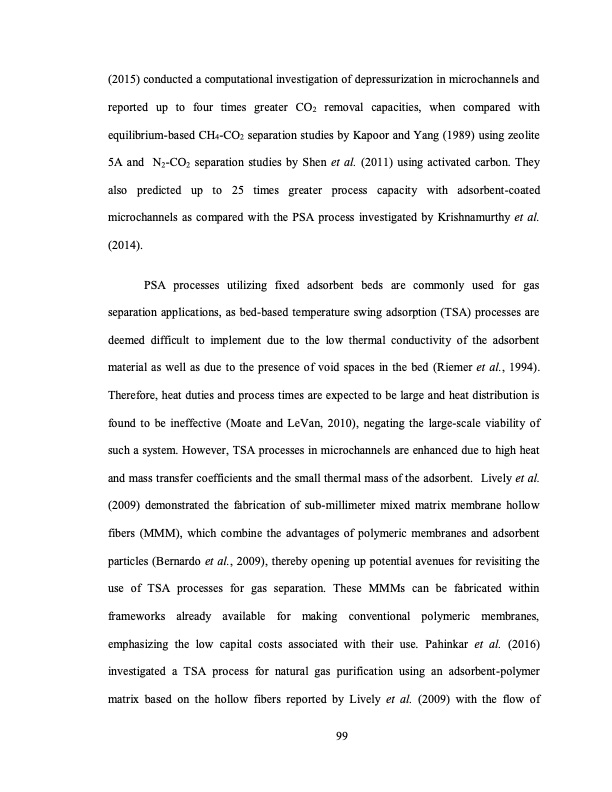
PDF Publication Title:
Text from PDF Page: 126
(2015) conducted a computational investigation of depressurization in microchannels and reported up to four times greater CO2 removal capacities, when compared with equilibrium-based CH4-CO2 separation studies by Kapoor and Yang (1989) using zeolite 5A and N2-CO2 separation studies by Shen et al. (2011) using activated carbon. They also predicted up to 25 times greater process capacity with adsorbent-coated microchannels as compared with the PSA process investigated by Krishnamurthy et al. (2014). PSA processes utilizing fixed adsorbent beds are commonly used for gas separation applications, as bed-based temperature swing adsorption (TSA) processes are deemed difficult to implement due to the low thermal conductivity of the adsorbent material as well as due to the presence of void spaces in the bed (Riemer et al., 1994). Therefore, heat duties and process times are expected to be large and heat distribution is found to be ineffective (Moate and LeVan, 2010), negating the large-scale viability of such a system. However, TSA processes in microchannels are enhanced due to high heat andmasstransfercoefficientsandthesmallthermalmassoftheadsorbent. Livelyetal. (2009) demonstrated the fabrication of sub-millimeter mixed matrix membrane hollow fibers (MMM), which combine the advantages of polymeric membranes and adsorbent particles (Bernardo et al., 2009), thereby opening up potential avenues for revisiting the use of TSA processes for gas separation. These MMMs can be fabricated within frameworks already available for making conventional polymeric membranes, emphasizing the low capital costs associated with their use. Pahinkar et al. (2016) investigated a TSA process for natural gas purification using an adsorbent-polymer matrix based on the hollow fibers reported by Lively et al. (2009) with the flow of 99PDF Image | TEMPERATURE SWING ADSORPTION PROCESSES FOR GAS SEPARATION

PDF Search Title:
TEMPERATURE SWING ADSORPTION PROCESSES FOR GAS SEPARATIONOriginal File Name Searched:
PAHINKAR-DISSERTATION-2016.pdfDIY PDF Search: Google It | Yahoo | Bing
CO2 Organic Rankine Cycle Experimenter Platform The supercritical CO2 phase change system is both a heat pump and organic rankine cycle which can be used for those purposes and as a supercritical extractor for advanced subcritical and supercritical extraction technology. Uses include producing nanoparticles, precious metal CO2 extraction, lithium battery recycling, and other applications... More Info
Heat Pumps CO2 ORC Heat Pump System Platform More Info
| CONTACT TEL: 608-238-6001 Email: greg@infinityturbine.com | RSS | AMP |